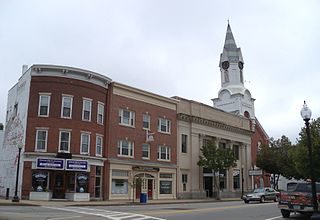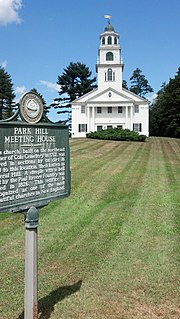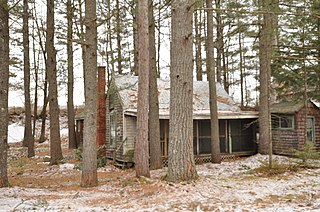
Rochester is a city in Strafford County, New Hampshire, United States. As of the 2020 census, the city population was 32,492. In addition to the downtown area, the city contains the villages of East Rochester, Gonic, and North Rochester. Rochester is home to Skyhaven Airport and part of Baxter Lake.

Charles Henry Sawyer was an American manufacturer, businessman and Republican politician. He served as a member of the New Hampshire House of Representatives and as the 41st governor of New Hampshire.

The Dr. Harrison A. Tucker Cottage is a historic summer cottage at 61 Ocean Avenue in Oak Bluffs, Massachusetts. The cottage took shape in the 1870s as a combination of several smaller structures that were joined by an addition. Doctor Tucker was a resident of Cottage City, as Oak Bluffs was then known, and invited Ulysses S. Grant during his time there. Tucker was also a leading figure in the Oak Bluffs Land and Wharf Company, which spearheaded development of the town outside the Methodist meeting camp known as Wesleyan Grove. The house was listed on the National Register of Historic Places in 1990, for its association with Dr. Tucker, and as one of the most elaborate Victorian houses in the town.

16 Mineral Street in Reading, Massachusetts is a well-preserved Second Empire cottage. It was built c. 1874 and probably moved to its present location not long afterward, during a building boom in that part of the town. It was listed on the National Register of Historic Places in 1984.
The Birches is a historic house on Foster Lane in Belgrade Lakes, Maine. Built in 1916 to a design by John Calvin Stevens and John Howard Stevens, it is the best-preserved surviving structure related to The Belgrade Hotel, a large summer resort hotel which burned down in 1955. It was listed on the National Register of Historic Places in 1996.

The Park Hill Meetinghouse is a historic meeting house on Park Hill in Westmoreland, New Hampshire. Built in 1764, and extensively restyled in the early 19th century, it is a fine example of Federal and Greek Revival architecture, influenced by the work of regionally prominent architect Elias Carter. The building was listed on the National Register of Historic Places in 1980. It is now owned by the Westmoreland Park Hill Meetinghouse and Historical Society.

The Finnish Congregational Church and Parsonage is a historic church at 172 St. George Road in South Thomaston, Maine, United States. Built in 1921, with the parsonage added about 1925, the church represents one of the earliest formal expressions of Finnish-American culture in the region. The buildings were listed on the National Register of Historic Places in 1994.

The Isabel and Chester Greenwood House is an historic house at 112 Hill Street in Farmington, Maine. Built in 1896, it is an architecturally distinctive sophisticated Queen Anne Victorian. It is also notable as the home of Chester Greenwood, who invented the earmuff. It was listed on the National Register of Historic Places in 1978.

The Church Hill Historic District is a mid-to-upper-class residential area north of Portage's downtown. It was added to the National Register of Historic Places in 1997 for its significance in architecture and social history.

The T. H. Cabot Cottage is a historic summer house off Snow Hill Road in Dublin, New Hampshire. The cottage is one several buildings that was built by geologist Raphael Pumpelly on his summer estate "Pompilia". Built in 1899 after his daughter's marriage to Thomas Handasyd Cabot, it is a good example of Georgian Revival architecture. The house was listed on the National Register of Historic Places in 1983.

The Kendall Cottage is a historic house on Breed Road in Harrisville, New Hampshire. Built in 1798, it is a well-preserved example of an early Cape-style hill country farmhouse, and one of a small number of surviving 18th-century buildings in the town. It was listed on the National Register of Historic Places in 1988.

The Capt. Thomas Morse Farm is a historic farmhouse on Old Marlborough Road in Dublin, New Hampshire. It is a small 1+1⁄2-story two-room cottage, similar to other early period Cape style farmhouses in the town and probably built in the late 18th century by one of the town's first settlers. Now a clubhouse for the Dublin Lake Golf Club, it is one of the few buildings from that period to survive. The house was listed on the National Register of Historic Places in 1983. It appears to have been torn down and replaced by a more modern structure.

The Stationmaster's House is a historic house on Jaquith Road in Harrisville, New Hampshire. Built in 1896, it is one of the few surviving elements of the town's historic railroad infrastructure. The house was listed on the National Register of Historic Places in 1988.

The Wood House is a historic house at the southeast corner of New Hampshire Routes 101 and 137 in Dublin, New Hampshire. Built in 1890, it is a locally distinctive example of Shingle style architecture with Romanesque features. The house was listed on the National Register of Historic Places in 1983.

The Gov. John Butler Smith House, also now known as the Community Building, is a historic house at 29 School Street in Hillsborough, New Hampshire. The large Queen Anne Victorian is significant as one of few known residential works of a prolific New Hampshire architect, William M. Butterfield, and as the home of John Butler Smith, a principal owner of the local Contoocook Mills, who also served as governor of New Hampshire (1893–95). The building was listed on the National Register of Historic Places in 2002.

The Louis St. Gaudens House and Studio is a historic house at Dingleton Hill and Whitten Roads in Cornish, New Hampshire. The 2+1⁄2-story gambrel-roofed wood-frame structure was designed by Moses Johnson and built in 1793–94 at the Shaker village in Enfield, New Hampshire. At that site the building served as the main meeting space for the Shakers, with a main meeting space on the ground floor, offices on the second floor, and guest living quarters in the attic space. The building is similar in construction to buildings designed by Johnson for the Shaker villages in Canterbury, New Hampshire and Sabbathday Lake, Maine.
The Old Gray House, also known as the Hodgden-Merrow House, is a historic house at 60 Tavenner Road, on Sawyers Island in Boothbay, Maine. The house, probably built in the 1820s, but possibly older, is built on a site that has been in documented use since the 1740s. It was listed on the National Register of Historic Places in 2007.

The Joseph and Susan Manley Summer Cottage is a historic house on Club Road in the Small Point area of Phippsburg, Maine. Built in 1887, it is one of the largest and most elaborate summer houses in the community, and is a fine Queen Anne structure designed by a prominent Maine architect. It was built for Joseph Homan Manley, a prominent Maine political operative, and was listed on the National Register of Historic Places in 1998.

The F.M. Jordan House is a historic house at 18 Laurel Street in Auburn, Maine. Built in 1881, it is one of the finest examples of Second Empire style in the state. It was built by Charles Jordan, a local master builder and distant relative of Francis Jordan, for whom it was built. The house was listed on the National Register of Historic Places in 2014. It is now subdivided into apartments.

The Moses Webster House is a historic house at 14 Atlantic Avenue in Vinalhaven, Maine. It was built in 1873 for Moses Webster, owner of one of Vinalhaven's granite quarries, and is one of the community's finest examples of Second Empire architecture. It was listed on the National Register of Historic Places in 1998.




















